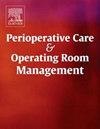Comparative efficacy of intrathecal morphine and posterior quadratus lumborum block for post-caesarean analgesia
IF 1
Q2 Nursing
Perioperative Care and Operating Room Management
Pub Date : 2025-09-22
DOI:10.1016/j.pcorm.2025.100559
引用次数: 0
Abstract
Background
Effective pain management after caesarean delivery is essential to promote maternal recovery, facilitate early mobility, and support mother-infant bonding. Traditionally, intrathecal morphine (ITM) has been widely used due to its strong analgesic effects, but concerns about opioid-related side effects have led to growing interest in alternative regional techniques such as the quadratus lumborum block (QLB). Comparative evidence on the efficacy of these approaches in obstetric patients remains limited.
Methods
In a randomized trial, 70 cesarean patients underwent spinal anesthetic at Assiut University Hospital. The study compared bilateral posterior QLB with 0.25 % bupivacaine to 100 μg ITM. Secondary outcomes included pain scores, time to first morphine request, side effects, quality of recovery, and functional outcomes; the primary outcome was 24-hour IV morphine consumption.
Results
Morphine consumption over 24 h was similar between the ITM and QLB groups, averaging 6.4 mg and 8.5 mg, respectively. Pain levels at rest and during movement did not differ significantly between the two groups at any time point. However, a subgroup analysis showed that QLB patients with a BMI of 30 kg/m² or higher required more morphine and reported higher peak pain scores compared to those in the ITM group (10.5 mg vs 7.4 mg, p < 0.05). No such difference was seen in patients with a BMI below 30 kg/m². In a multivariate analysis, BMI emerged as the only significant predictor of 24-hour morphine consumption (p = 0.016).
Conclusion
ITM and posterior QLB provide comparable postoperative analgesia after cesarean delivery for the general population. However, patient factors such as BMI and age may influence postoperative opioid requirements and should be considered when selecting an analgesic technique to optimize recovery and minimize side effects.
鞘内吗啡与腰方肌后阻滞用于剖宫产后镇痛的比较疗效
背景剖宫产后有效的疼痛管理对于促进产妇康复、促进早期活动和支持母婴关系至关重要。传统上,鞘内吗啡(ITM)因其强大的镇痛作用而被广泛使用,但对阿片类药物相关副作用的担忧导致人们对替代区域性技术(如腰方肌阻滞(QLB))的兴趣日益浓厚。关于这些方法在产科患者中的疗效的比较证据仍然有限。方法对70例剖宫产患者在阿西尤特大学医院行脊髓麻醉进行随机对照试验。该研究将双侧后路QLB与0.25%布比卡因和100 μg ITM进行比较。次要结局包括疼痛评分、到第一次吗啡请求的时间、副作用、恢复质量和功能结局;主要终点为24小时静脉注射吗啡。结果ITM组和QLB组24 h吗啡摄取量相似,平均分别为6.4 mg和8.5 mg。两组在休息和运动时的疼痛水平在任何时间点均无显著差异。然而,亚组分析显示,与ITM组相比,BMI为30 kg/m²或更高的QLB患者需要更多的吗啡,并报告更高的峰值疼痛评分(10.5 mg vs 7.4 mg, p < 0.05)。BMI低于30 kg/m²的患者没有这种差异。在多变量分析中,BMI是24小时吗啡摄入量的唯一显著预测因子(p = 0.016)。结论itm与后路QLB对一般人群剖宫产术后镇痛效果相当。然而,BMI和年龄等患者因素可能会影响术后阿片类药物的需求,在选择镇痛技术时应考虑这些因素,以优化恢复并减少副作用。
本文章由计算机程序翻译,如有差异,请以英文原文为准。
求助全文
约1分钟内获得全文
求助全文
来源期刊

Perioperative Care and Operating Room Management
Nursing-Medical and Surgical Nursing
CiteScore
1.30
自引率
0.00%
发文量
52
审稿时长
56 days
期刊介绍:
The objective of this new online journal is to serve as a multidisciplinary, peer-reviewed source of information related to the administrative, economic, operational, safety, and quality aspects of the ambulatory and in-patient operating room and interventional procedural processes. The journal will provide high-quality information and research findings on operational and system-based approaches to ensure safe, coordinated, and high-value periprocedural care. With the current focus on value in health care it is essential that there is a venue for researchers to publish articles on quality improvement process initiatives, process flow modeling, information management, efficient design, cost improvement, use of novel technologies, and management.
 求助内容:
求助内容: 应助结果提醒方式:
应助结果提醒方式:


